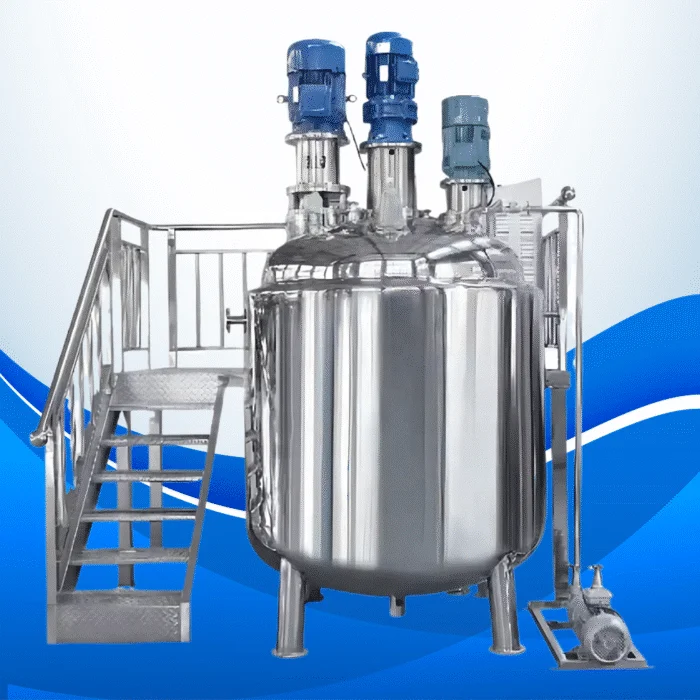Achieving a homogeneous mixture is crucial in many manufacturing processes, especially in industries like food, pharmaceuticals, chemicals, and cosmetics. A homogeneous mixture ensures that the final product is uniform in quality, stability, and consistency. One of the most effective tools for achieving this is the Jacket Mixing Tank. This versatile equipment offers a range of benefits for manufacturers looking to improve the quality of their products while optimizing production efficiency.
What Is a Jacket Mixing Tank?
A Jacket Mixing Tank is an industrial piece of equipment used to mix and heat substances simultaneously. The tank is equipped with an external jacket that can be heated or cooled, providing precise temperature control for the contents inside. The mixing mechanism inside the tank ensures that all ingredients are blended evenly and thoroughly, creating a uniform mixture.
These tanks are widely used in industries that require both consistent mixing and temperature control, such as in the food and beverage industry, pharmaceuticals, and chemicals. The combination of heating and mixing in a single tank helps reduce production time and ensures that each batch meets the desired quality standards.
Achieving Homogeneous Mixing with Precision
Homogeneous mixing refers to the process of ensuring that all components of a mixture are evenly distributed and integrated. In many industries, achieving this level of uniformity is essential for the consistency and safety of the final product. Whether it’s a food product, pharmaceutical solution, or cosmetic cream, an uneven mixture can result in variations in texture, flavor, or potency.
The Jacket Mixing Tank helps achieve homogeneous mixing by providing precise control over both temperature and mixing speed. The external jacket allows for the even application of heat or cold, preventing hotspots or areas where the temperature might be too high or low. This ensures that ingredients are not only mixed well but also processed under ideal conditions for maximum efficiency.
The mixing mechanism inside the tank also plays a significant role in achieving uniformity. Different types of mixers, such as impellers, anchors, or turbines, can be used depending on the viscosity and nature of the ingredients. This flexibility enables manufacturers to select the most suitable mixing method for their specific requirements, thereby further enhancing the homogeneity of the final product.
Temperature Control for Optimal Mixing
Temperature control is a vital factor in achieving homogeneous mixing. Many ingredients require specific temperatures to mix properly. For instance, some substances may solidify or clump together at too low a temperature, while others may degrade or separate at too high a temperature. The Jacket Mixing Tank provides precise temperature regulation, enabling manufacturers to maintain optimal conditions for their products.
The jacket surrounding the tank can be heated or cooled depending on the requirements of the mixture. This feature is especially beneficial when working with temperature-sensitive ingredients, such as in the production of emulsions, creams, or syrups. By maintaining a consistent temperature throughout the mixing process, the Jacket Mixing Tank ensures that all ingredients are processed evenly, preventing the formation of lumps, bubbles, or separation.
Moreover, the ability to control the temperature reduces the risk of thermal damage to delicate ingredients, which could otherwise affect the quality and consistency of the product. This precise control helps manufacturers produce high-quality, homogeneous mixtures that meet industry standards and consumer expectations.
Reducing Mixing Time and Improving Efficiency
In addition to ensuring homogeneous mixing, the Jacket Mixing Tank also offers significant benefits in terms of efficiency. Traditional mixing methods can be time-consuming and require multiple steps, often involving separate tanks for heating and mixing. By combining both functions in a single unit, the Jacket Mixing Tank streamlines the process, reducing production time and improving overall efficiency.
With faster mixing times, manufacturers can increase their output without compromising product quality. This is especially important for large-scale production, where the ability to produce consistent, homogeneous mixtures quickly can lead to significant cost savings. Moreover, the precise temperature control provided by the tank ensures that each batch is processed under optimal conditions, minimizing the risk of errors or inconsistencies.
The Jacket Mixing Tank also helps reduce energy consumption by optimizing the heating process. Since the jacket provides uniform heat distribution, less energy is required to reach the desired temperature. This not only reduces costs but also makes the production process more environmentally friendly.
Versatility in Various Industries
The flexibility of the Jacket Mixing Tank makes it an essential tool in a wide range of industries. Its ability to handle both temperature control and mixing simultaneously allows it to be used for a variety of applications, from food and beverage production to pharmaceuticals and chemicals.
In the food industry, for example, Jacket Mixing Tanks are used to produce a wide range of products, including sauces, soups, dairy products, and beverages. The ability to mix ingredients while controlling the temperature ensures that products are consistent and of high quality, meeting both regulatory requirements and consumer expectations.
In the pharmaceutical industry, Jacket Mixing Tanks are used to produce creams, lotions, ointments, and other topical products. These tanks ensure that active ingredients are evenly distributed and that the final product meets the required potency and consistency standards.
The chemical industry also benefits from the versatility of Jacket Mixing Tanks, using them for the production of adhesives, coatings, and other complex formulations that require both mixing and precise temperature control.
Cost-Effectiveness and Sustainability
While the initial investment in a Jacket Mixing Tank may seem significant, the long-term benefits far outweigh the costs. By reducing production time, improving efficiency, and ensuring the quality of the product, these tanks contribute to a more cost-effective manufacturing process.
In addition to cost savings, the Jacket Mixing Tank offers sustainability benefits. The energy-efficient design of the tank minimizes energy consumption, reducing the environmental impact of the production process. The precise temperature control also ensures that ingredients are processed under optimal conditions, reducing waste and minimizing the need for rework.
By investing in a Jacket Mixing Tank, manufacturers can achieve both economic and environmental benefits, making it a smart choice for businesses looking to improve their production processes while maintaining high-quality standards.
Conclusion
The Jacket Mixing Tank is an essential tool for achieving homogeneous mixing in various industries. By providing precise temperature control and efficient mixing, these tanks help ensure the uniformity and consistency of the final product. Whether used in food, pharmaceuticals, chemicals, or cosmetics, the Jacket Mixing Tank plays a crucial role in improving product quality, reducing production time, and enhancing overall efficiency.
For manufacturers seeking to streamline their production processes and meet the demands of their industries, the Jacket Mixing Tank is a valuable investment. It not only helps create homogeneous mixtures but also offers significant cost savings and sustainability benefits, making it a key asset in any manufacturing operation.



